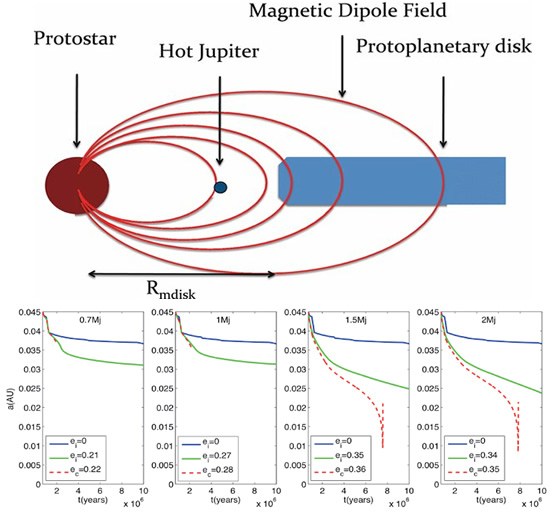Research Gallery > Planetary Sciences
Research Gallery
Planetary Sciences
| Tidal and Magnetic Interactions Between a Hot Jupiter and its Host Star in the Magnetospheric Cavity of a Protoplanetary Disk |
|
Image Credit: Chang, Gu and Bodenheimer

The upper plot illustrates our model, which shows a hot Jupiter orbiting a CTTS in a magnetospheric cavity of a protoplanetary disk. The initial orbit of the planet is set to lie at the 2:1 orbital resonance with the inner edge of the disk. The lower plot shows the orbital evolution through tidal and magnetic interactions between a hot Jupiter and its host star in a magnetospheric cavity. Four cases are presented in terms of different initial masses: 0.7, 1, 1.5, and 2 Jupiter masses (Mj). Each panel has three different tracks by modulating the initial eccentricity. The blue line is the orbital evolution of a planet in a circular orbit; the green line illustrates the case in which the planet of a given initial mass can migrate inward over the longest distance; the red line shows that the planet with a critical eccentricity destructs at the breaking point.
|
| Hot Jupiters are so close to their parent stars that their equilibrium temperatures can soar up to 1,000-2,000K. There exists an intriguing phenomenon for these "toasted exoplanets": no hot Jupiters of mass less than 1 Jupiter mass have been found within 0.03AU from their parent stars. A model has been constructed to explore the cause. When the system is in the T Tauri star phase, the strong magnetic dipole fields of the protostar truncate the inner part of the proto-planetary disk at the disk radius Rmdisk, forming a magnetospheric cavity. A young hot Jupiter is expected to lie in the magnetospheric cavity. If the young planet starts with an eccentric orbit, tidal dissipation can expand the planet. As shown in the figure below, a less massive planet requires a smaller critical eccentricity to be disrupted, meaning that tidal dissipation
can inflate a less massive planet more easily, leading to the demise of a less massive hot Jupiter due to the runaway mass loss via Roche-lobe overflow. |
 asiaa.sinica.edu.tw Media Request: epo
asiaa.sinica.edu.tw Media Request: epo asiaa.sinica.edu.tw
asiaa.sinica.edu.tw 
